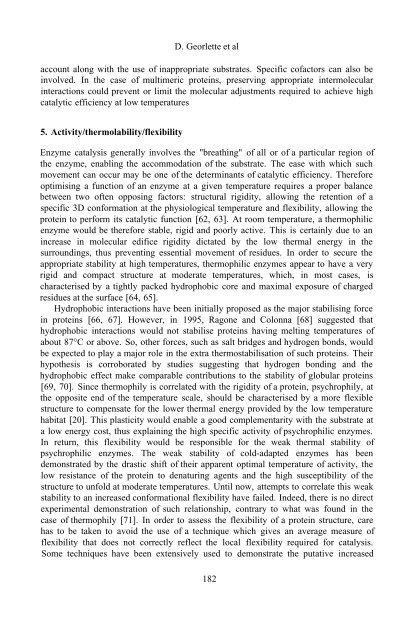Physics And Chemistry Basis Of Biotechnology - De Cuyper - tiera.ru
Physics And Chemistry Basis Of Biotechnology - De Cuyper - tiera.ru
Physics And Chemistry Basis Of Biotechnology - De Cuyper - tiera.ru
Create successful ePaper yourself
Turn your PDF publications into a flip-book with our unique Google optimized e-Paper software.
D. Georlette et al<br />
account along with the use of inappropriate substrates. Specific cofactors can also be<br />
involved. In the case of multimeric proteins, preserving appropriate intermolecular<br />
interactions could prevent or limit the molecular adjustments required to achieve high<br />
catalytic efficiency at low temperatures<br />
5. Activity/thermolability/flexibility<br />
Enzyme catalysis generally involves the "breathing" of all or of a particular region of<br />
the enzyme, enabling the accommodation of the substrate. The ease with which such<br />
movement can occur may be one of the determinants of catalytic efficiency. Therefore<br />
optimising a function of an enzyme at a given temperature requires a proper balance<br />
between two often opposing factors: st<strong>ru</strong>ctural rigidity, allowing the retention of a<br />
specific 3D conformation at the physiological temperature and flexibility, allowing the<br />
protein to perform its catalytic function [62, 63]. At room temperature, a thermophilic<br />
enzyme would be therefore stable, rigid and poorly active. This is certainly due to an<br />
increase in molecular edifice rigidity dictated by the low thermal energy in the<br />
surroundings, thus preventing essential movement of residues. In order to secure the<br />
appropriate stability at high temperatures, thermophilic enzymes appear to have a very<br />
rigid and compact st<strong>ru</strong>cture at moderate temperatures, which, in most cases, is<br />
characterised by a tightly packed hydrophobic core and maximal exposure of charged<br />
residues at the surface [64, 65].<br />
Hydrophobic interactions have been initially proposed as the major stabilising force<br />
in proteins [66, 67]. However, in 1995, Ragone and Colonna [68] suggested that<br />
hydrophobic interactions would not stabilise proteins having melting temperatures of<br />
about 87°C or above. So, other forces, such as salt bridges and hydrogen bonds, would<br />
be expected to play a major role in the extra thermostabilisation of such proteins. Their<br />
hypothesis is corroborated by studies suggesting that hydrogen bonding and the<br />
hydrophobic effect make comparable contributions to the stability of globular proteins<br />
[69, 70]. Since thermophily is correlated with the rigidity of a protein, psychrophily, at<br />
the opposite end of the temperature scale, should be characterised by a more flexible<br />
st<strong>ru</strong>cture to compensate for the lower thermal energy provided by the low temperature<br />
habitat [20]. This plasticity would enable a good complementarity with the substrate at<br />
a low energy cost, thus explaining the high specific activity of psychrophilic enzymes.<br />
In return, this flexibility would be responsible for the weak thermal stability of<br />
psychrophilic enzymes. The weak stability of cold-adapted enzymes has been<br />
demonstrated by the drastic shift of their apparent optimal temperature of activity, the<br />
low resistance of the protein to denaturing agents and the high susceptibility of the<br />
st<strong>ru</strong>cture to unfold at moderate temperatures. Until now, attempts to correlate this weak<br />
stability to an increased conformational flexibility have failed. Indeed, there is no direct<br />
experimental demonstration of such relationship, contrary to what was found in the<br />
case of thermophily [71]. In order to assess the flexibility of a protein st<strong>ru</strong>cture, care<br />
has to be taken to avoid the use of a technique which gives an average measure of<br />
flexibility that does not correctly reflect the local flexibility required for catalysis.<br />
Some techniques have been extensively used to demonstrate the putative increased<br />
182












